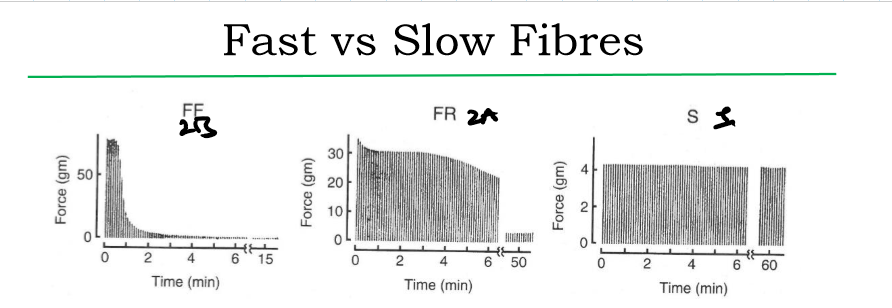L14 Skeletal muscle mechanics
1/20
There's no tags or description
Looks like no tags are added yet.
Name | Mastery | Learn | Test | Matching | Spaced |
|---|
No study sessions yet.
21 Terms
What is the length–tension relationship?
The relationship between muscle length and the force (tension) it produces during contraction.
What is passive tension?
What is active tension?
Force needed to stretch the muscle
Force generated by muscle contraction
At what length does maximal active tension occur?
At optimum length (L₀), where all myosin heads can bind to actin.
What happens when muscle is longer than L₀?
What happens when muscle is shorter than L₀?
Fewer cross-bridges can form as actin myosin overlap is reduced → less force
Actin filaments overlap and myosin hits z discs causing interfere (steric hindrance) → less force.
What is the typical range for active force generation?
70–130% of L₀.
Series vs parallel elastic
Series: tendons, connective tissues in series with contractile elements
Parallel: sarcomere proteins especially titin and extracellular sheaths around fibres
What is an isometric contraction?
What is an isotonic contraction?
What is an auxotonic contraction?
What are concentric and eccentric contractions?
Muscle develops tension but does not change length (e.g. holding a load).
Muscle shortens under constant load (force remains constant)
Concentric: Muscle shortens while contracting (lifting a weight).
Eccentric: Muscle lengthens while contracting (lowering a weight).
Contraction against a variable load (e.g. stretching a spring)
What is preload?
What is afterload?
When does muscle shortening begin?
The initial load (stretch) on the muscle before contraction, setting its starting length.
The load the muscle must lift during contraction.
Shortening begins when the muscle’s force exceeds the afterload(isotonic)
What is the relationship between force and velocity?
Inversely related — as load increases, shortening velocity decreases.
How does the load determine myosin attachment and detachment for light and heavy loads
If the load is heavy and the filament isn’t moving (isometric):
Myosin head attach and stay bound longer (detachment slower under strain)
More heads accumulate in the attached site so more force generated but little shortening
If the load is light the filament moves quickly (concentric):
heads detach faster (detachment faster under low strain)
Fewer head attached so less force but higher velocity
high force= lower velocity (many cross bridges attached)
low force= high velocity (few cross bridges attached)
What happens in eccentric contractions?
External force exceeds muscle tension → muscle is stretched while contracting → very high force generated.
What is a muscle twitch?
A single contraction from one AP in a motor neuron.
What is summation?
Why can twitches summate but APs cannot?
The additive effect of multiple twitches due to repeated stimulation before full relaxation.
Twitches are mechanical and last longer than APs; APs are refractory and brief.
What is tetanus?
What is clonus?
Sustained maximal contraction from high-frequency stimulation — many fused twitches.
Partial, rhythmic contractions — incomplete tetanus.
Why does more frequent stimulation increase force?
AP triggers calcium release from SR so calcium levels rise fast but falls quickly as calcium is pumped back into the SR
Force lags behind calcium as calcium bind troponin causing it to move and allowing cross bridges formation. This then cycle and stretch elastic elements so when force peaks calcium is already falling
When there is more frequent APs, calcium levels kept high so mor cross bridges meaning greater force
How long is a muscle AP compared to a twitch?
AP ≈ 5–10 ms; Twitch ≈ 100+ ms.
What is a motor unit?
small vs large motor units: how many fibres and use
One motor neuron and all the muscle fibers it innervates.
Small motor units: few fibers, fine control (e.g. eye muscles)
Large motor units: many fibers, powerful movement (e.g. leg muscles)
What are the three main energy sources for ATP in muscle?
What is their speed, how many ATP they make per glucose and when are they used
PGO
Phosphocreatine (creatine phosphate): very very fast, direct transfer (no glucose used) rapid ATP regeneration, immediatly
Glycolysis: fast, 2 ATP per glucose, short high power
Oxidative phosphorylation: slow, ~36 ATP per glucose or fat oxidation, long term
What is the order of motor unit recruitment?
Slow (small) → fast oxidative → fast glycolytic.
What are the three main muscle fiber types?
Mention speed, force, fatigue resistance, metabolism method it uses
Type I (slow oxidative): slow, low force, fatigue-resistant, use oxidative phosphorylation
Type IIa (fast oxidative):moderate speed, moderate force, moderate fatigue resistance, glycolysis and oxidation
Type IIb (fast glycolytic): very fast, high force, fast fatigue, glycolysis

Name the type of muscle fibers they are
1, 2a, 2b
